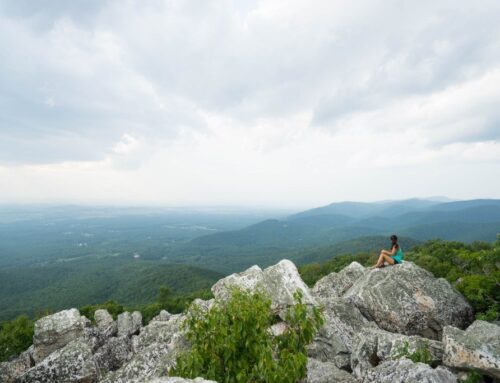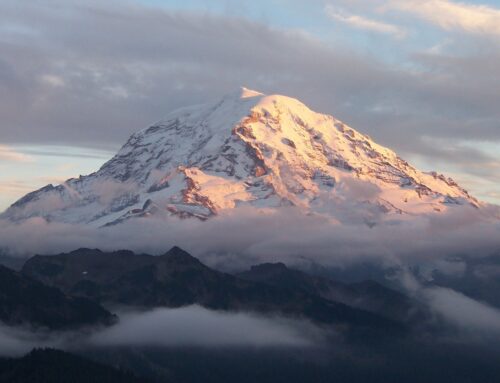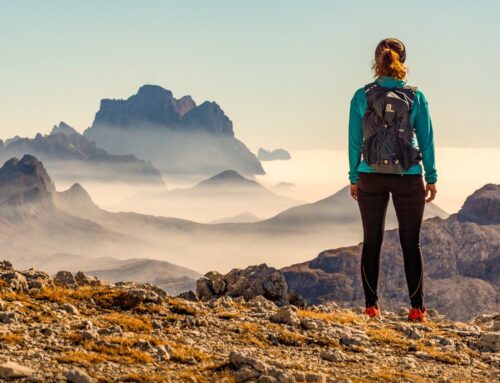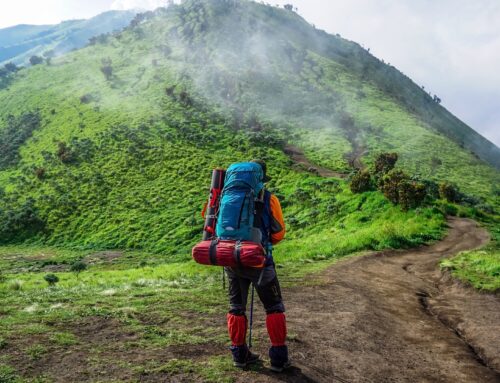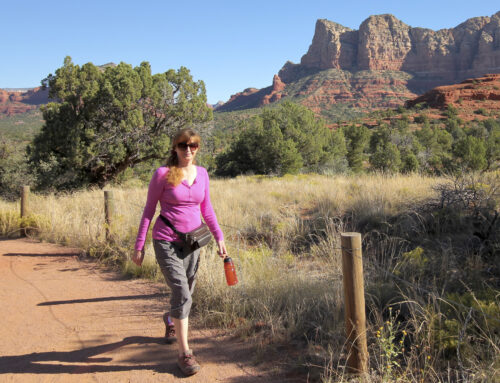Updated June 24, 2021
As one of the most popular national parks in the United States, Rocky Mountain National Park has no shortage of things to do or trails to explore. One of the most fun and rewarding ways to explore the park is on foot – hiking in Rocky National Park offers limitless possibilities with a network of interconnected trails you can explore for days on end. At just 1.5 hours from Denver and 1 hour from Boulder, this national park is accessible to hikers of any experience level. From easy strolls to challenging summits, we created this guide to the best hikes in Rocky Mountain National Park so you can plan an incredible adventure!

Easy Hiking in Rocky Mountain National Park
Sprague Lake
- Trail Length: 0.8 miles
- Elevation Gain: Minimal
One of the most accessible (and beautiful) easy hikes in Rocky Mountain National Park is Sprague Lake. Situated on the banks of its namesake lake, this trail offers breathtaking views of the surrounding mountains and emerald pine forests. Additionally, there are benches and picnic tables for those wanting to stop and eat lunch or enjoy the gorgeous scenery. It’s especially beautiful in the early morning and around sunset, when the water is still and you can see the reflections of the mountains.
This short, easy trail is made largely of packed dirt so it’s accessible to strollers and wheelchairs, and there are plenty of places to stop and catch your breath. I’d especially recommend this trail for those who are short on time, families with kids, and anyone who needs wheelchair/stroller access.
Glacier Gorge & Alberta Falls
- Trail Length: 1.6 miles+
- Elevation Gain: 252 feet
The Glacier Gorge trailhead is one of the most popular trailheads for hiking in Rocky Mountain National Park, as it winds through a scenic gorge to many of the park’s most beautiful viewpoints. Because of this, it’s a fantastic spot to begin your adventures in the park.
If you want to do a shorter hike, the first main stopping point on the Glacier Gorge trail is Alberta Falls, which is about 1.6 miles round trip from the parking lot (0.8 miles one way). These falls are beautiful and the trail to get there is accessible to hikers of all levels, and there are lots of areas to stop and have a snack or enjoy the views. For those wanting to tack on a bit more of a challenge, this easy trail continues on to the more difficult, steep hike up to the Loch and, finally, Sky Pond (see below).
Note that since this is one of the most popular trailheads, the small parking lot nearby fills up extremely early in the morning during peak season. I recommend getting there early (6 AM or earlier) or prepare to take the shuttle from either the Bear Lake trailhead or the satellite lot.

Bear Lake
- Trail Length: 0.7 miles
- Elevation Gain: Minimal
Another extremely popular trailhead in Rocky Mountain National Park is the Bear Lake trailhead. As its name suggests, the Bear Lake trail is the one closest to the parking lot that wraps around a scenic lake surrounded by mountains. If you want to experience the beauty of Rocky Mountain National Park without doing any strenuous or steep hiking, Bear Lake is a great option.
This short, easy hike is great for families with kids or those who are crunched for time, but the gravel trail unfortunately isn’t suitable for wheelchairs or strollers. Because it’s so easily accessible and beginner-friendly, the Bear Lake trail does get quite crowded during peak times/seasons. If you don’t plan on going early in the morning or later in the evening, you may need to park in a satellite lot and take a shuttle to the trailhead.
Dream Lake
- Trail Length: 2.0 miles
- Elevation Gain: 426 feet
Beginning at the Bear Lake Trail, Dream Lake is another picturesque lake accessed by one of the easier hikes in Rocky Mountain National Park. At 2 miles in length, this trail is a little bit longer than some of the other easy hikes I’ve mentioned, which is perfect for those wanting a longer adventure without any difficult terrain.
On this trail, you’ll pass by Bear Lake and continue through a mostly wooded trail to Dream Lake. There’s a gentle elevation gain on the way up, but the trail is really well-maintained and the scenery is gorgeous. En route to Dream Lake, you’ll pass Nymph Lake, another spectacular alpine lake surrounded by mountains and trees.
Finally, you’ll arrive at Dream Lake after about a mile of hiking, and it’s a good place to stop and eat a snack, catch your breath, and admire the jaw-dropping scenery of the Rockies.

Bierstadt Lake Loop
- Trail Length: 3.2 miles
- Elevation Gain: 626 feet
As another longer easy trail for hiking in Rocky Mountain National Park, the Bierstadt Lake Loop Trail is a 3.2-mile gem in the heart of the park. Surrounded by – you guessed it – snow-capped mountaintops and bright green forests, it’s a popular place for photography in the early morning and a lovely place to take a leisurely hike at any time of day. There is a bit of an uphill hike to get to the lake, with some gentle to moderate elevation gain, but once you arrive you’ll have plenty of space to roam around and enjoy the views.

Moderate Hikes in Rocky Mountain National Park
Four Lakes Loop
- Trail Length: 7 miles
- Elevation Gain: 702 feet
Hilariously enough, the “Four Lake Trail” is a misnomer, as this trail actually passes five lakes: Bear Lake, Nymph Lake, Dream Lake, Emerald Lake, and Haiyaha Lake. And if you’re up for a little bit of a challenge, this is probably our favorite of the moderate hikes in Rocky Mountain National Park. Like I mentioned, this trail starts at Bear Lake and passes five stunning alpine lakes, each with its own glassy water and mountainous views.
At 7 miles, this half-day hike is a great way to explore the area surrounding the Bear Lake trailhead. There are a few spots of moderate elevation gain, especially in the switchbacks leading to Haiyaha Lake. I’d recommend getting to the trail early in the morning, as parking does fill up around Bear Lake by mid-morning. Otherwise, you’ll likely have to take a shuttle from the satellite lot.
Pro tip: When I last hiked this trail, it was very clearly marked except around Haiyaha Lake. When you approach the banks of the lake, it can get a little dicey. Once we (my friend and I) got there and perched ourselves on a rock for a while, we actually couldn’t figure out where the trail to leave was. After some climbing through trees and looking at Google Maps, we eventually found the trail again, but we’d strongly recommend taking a mental note or using an app for returning back to the trail.

Gem Lake
- Trail Length: 3.4 miles
- Elevation Gain: 990 feet
Gem Lake has to be one of the coolest and most unique hikes in Rocky Mountain National Park. While I didn’t get to do this hike during my time at the park, it’s really high on my list for next time. This 3.4-mile trail takes you through the forest and up to a scenic lake surrounded by otherworldly rock formations, sandy shorelines, and strange, knobby trees. You’ll often see photographers in the area during the earlier hours of the day trying to capture this fascinating lakefront area.
As the shortest moderate hike on our list, we’d recommend Gem Lake for hikers on a time crunch who want to tackle a little bit of elevation gain and still see something cool.
Deer Mountain
- Trail Length: 6 miles
- Elevation Gain: 1,400 feet
Another RMNP hike I didn’t get to do but wanted to is Deer Mountain. As one of the more accessible summits in the park to beginners and leisure hikers, this trail offers beautiful, sweeping views of the park’s valleys and the mountains around them. Additionally, at 6 miles, it’s a bit of a longer hike you can enjoy in a half-day or more, and the summit is a great spot for lunch or a break to admire the panoramic views.

Hard Hikes in Rocky Mountain National Park
These are some of the most incredible spots for hiking in Rocky Mountain National Park, but are only for hikers with lots of experience hiking rough, steep terrain. Additionally, certain times of year pose a significant risk of avalanches and dangerous conditions, so check with local authorities and proceed with caution.
Sky Pond
- Trail Length: 8.5 miles
- Elevation Gain: 1,761 feet
Among many hikers, Sky Pond is a crowd favorite of all of the hikes in Rocky Mountain National Park. Beginning at the Glacier Gorge trailhead, it’s got a little bit of everything, from waterfalls to gorge views to lake views and mountain peaks. It’s no surprise that this is also one of the most popular hard hikes in the entire park, attracting lots of ambitious hikers every day.
Most of the ascent is actually moderate as you pass by Alberta Falls and the Loch. However, once you pass the Loch area and begin climbing up a steeper ascent, you’re in for a real challenge. There’s a sizeable waterfall you’ll pass to your left, then a rocky scramble for several minutes until you get to Glass Lake. From there, you’ll continue to climb over the rocks to get to the hike’s final destination: Sky Pond. The peaks up here look like spires against the sky, and if it’s not too windy, you may even catch their reflection in the pond.
Pro tip: Even if it’s warm at the trailhead, bring gloves and a hat for the top. We went unprepared and were freezing at Sky Pond, even though the ascent was in fairly warm weather.

Chasm Lake
- Trail Length: 9.4 miles
- Elevation Gain: 2,601 feet
Another one of the most popular hard hikes in Rocky Mountain National Park is the trail to Chasm Lake, a gorgeous alpine lake that has stellar views of the rocky peaks and formations nearby, including Longs Peak. With 2,601 feet of elevation gain over 9.4 miles, this hike is strenuous and is suitable for experienced hikers only.
On the way to the top, you’ll traverse through moderate terrain at first, and then the trail gets significantly steeper as you work your way to the lake. The final push to the lake is a rock scramble with a very steep ascent, so be prepared. Once you arrive, you can stop for a snack and a break at this scenic lake, or continue on to summit Longs Peak (see details below).

Flattop Mountain & Hallett Peak
- Trail Length: 10.3 miles
- Elevation Gain: 3,293 feet
One of the most beloved summit hikes in Rocky Mountain National Park is the Flattop Mountain and Hallett Peak hike, which spans just over 10 miles and 3,293 feet of elevation gain. This challenging trail is a fantastic way to get panoramic park views without attempting something quite as hard as Longs Peak.
Summiting two peaks in one hike, you’ll get access to several different viewpoints as you traverse this scenic trail. Note that the trail can get extremely windy and cold above the tree line! The last push to the summit of Hallett Peak requires some scrambling, and you may need crampons, microspikes, or snowshoes if you intend to hike during the late fall, winter, or early spring. As always, check in with local rangers to determine if there’s significant avalanche risk before hiking.

Longs Peak
- Trail Length: 14.8 miles
- Elevation Gain: 5,039 feet
If you’re an experienced hiker looking to bag a Colorado 14er in Rocky Mountain National Park, Longs Peak is your only choice. A 14.8 mile trail with over 5,000 feet of elevation gain, this hike is not for the inexperienced or the faint of heart. The trail to the summit is rated a Class 3 on the Yosemite Decimal System, which means there’s significant scrambling and climbing involved to get to the summit. However, if you’re prepared and choose to tackle this thrilling trail, the rewards and views are second to none.
For those who want to do this hike, we recommend arriving at the trail head well before sunrise, as this hike will take a very full day to complete. Most hikers begin around 4 AM – some earlier. The hike to the ascent is quite steep, with the most difficult scrambling and climbing occurring after you reach the Keyhole rock formation. The views from the top are some of the best in the park – well worth the effort to get there!
Additional Resources
What to Bring Hiking
- Breathable hiking clothes – For warmer hikes, you’ll want to wear a sweat-wicking shirt and breathable pants, like these Patagonia hiking shorts for men and women. For cold-weather hikes, we recommend dressing in layers, including merino wool baselayers for men and women, a down puffer jacket for men and women, and a Northface waterproof outer shell for men and women (a must for hiking in Seattle). And don’t forget a pair of the best women’s and men’s hiking socks!
- Trekking poles – You won’t need these for every single hike, but we suggest throwing them in your car just in case. We recommend the Black Diamond Trail Ergo cork trekking poles, which are lightweight, easy to transport, and durable.
- Water bottle – Having water available at all times is a huge must. To limit disposable plastic, we recommend bringing your own refillable water bottle. We’re obsessed with Hydro Flask water bottles because they keep water cold for hours.
- Sunscreen and bug spray – Sweatproof sunscreen and DEET bug spray can help you avoid sunburn and bug bites, two of hiking’s most annoying after-effects. Our favorite kind of sunscreen is Sun Bum, as it is free of harsh chemicals and safe for marine life, including coral reefs.
- A brimmed hat or cap – The sun can be brutal in open hikes, so always pack a brimmed hat or cap for day hikes in the sunshine.
- Emergency blanket and first aid kit – We’d strongly recommend bringing a first aid kit and a lightweight emergency blanket on every hike. Why? Because the unfathomable can happen, and it’s always best to play it safe.
- Durable day pack – A durable day pack is the perfect spot to stash all your hiking gear. While any backpack will do, we recommend the Osprey Tempest 20 or the Talon 22 day packs because they’re comfortable and breathable for long hikes. For more information, check out our best day packs for any terrain guide.
Wondering what exactly you should pack for your next hike? Visit our Complete Day Hiking Packing List for our full list and our top gear recommendations.

